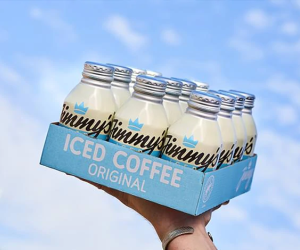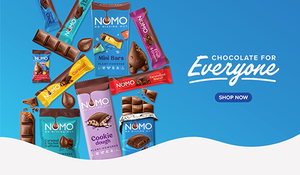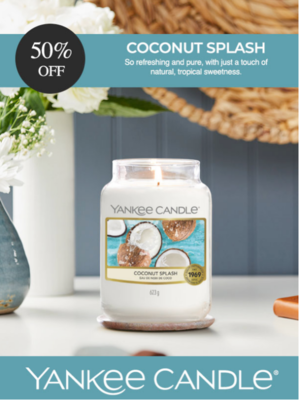It’s a common problem—ice cream texture changes when refrozen. Discover why this happens and learn hints and tips to prevent grainy, dense refrozen ice cream.
People often ask, “Why does refrozen ice cream have a different texture?” It’s a common issue many of us face – perfectly smooth and creamy ice cream suddenly becomes grainy and dense after being refrozen.
In this article, we’ll explore the science behind this change, explain why it happens, and offer practical tips to help you manage or avoid this texture shift altogether.
Whether you’re looking to understand the process or hoping to save your favourite frozen treat, we’ve got the answers to help you enjoy your ice cream at its best!
Why Does Refrozen Ice Cream Have a Different Texture?
 If you’ve ever had the unfortunate experience of digging into a tub of refrozen ice cream, only to find it grainy, dense, and just not quite right, you’re not alone. It’s a common occurrence that leaves many wondering why refreezing ice cream changes it so much.
If you’ve ever had the unfortunate experience of digging into a tub of refrozen ice cream, only to find it grainy, dense, and just not quite right, you’re not alone. It’s a common occurrence that leaves many wondering why refreezing ice cream changes it so much.
Let’s get into the science behind this phenomenon and how you can prevent your favourite frozen treat from turning into a disappointment.
A Common Homemade Ice Cream Dilemma
We’ve all been there. You’re in the mood for some ice cream but decide to let it sit out for a few minutes to soften, and then you forget about it. When you finally remember, the ice cream has turned into a soupy mess.
After hastily putting it back in the freezer, you hope for the best, but when you go to enjoy it later, it’s hard, grainy, and definitely not the smooth deliciousness it was before. Why does this happen?
The answer lies in the delicate structure of ice cream and the science behind freezing and refreezing.
How Ice Cream is Made
To understand why refreezing changes ice cream, we need to look at how it’s made.
 Ice cream is a carefully balanced blend of milk, cream, sugar, and sometimes eggs, all churned together while being rapidly frozen. This process is essential for creating the smooth, creamy texture that we love.
Ice cream is a carefully balanced blend of milk, cream, sugar, and sometimes eggs, all churned together while being rapidly frozen. This process is essential for creating the smooth, creamy texture that we love.
As the ice cream churns, air is incorporated into the mixture, making it light and fluffy. In fact, up to 50% of the volume of ice cream can be air. Without this air, ice cream would be hard and dense, more like an ice cube
I remember making homemade ice cream with my family one summer. We used an old-fashioned hand-crank ice cream maker, and the churning seemed to go on forever. But the result was worth it—smooth, velvety ice cream. That day, I learned firsthand how vital the churning process is to the final product!
What Happens When Ice Cream Melts
 Aside from the obvious, when ice cream melts, the balance between its components starts to break down. Ice crystals, which are microscopic and evenly distributed when the ice cream is fresh, begin to melt. The air bubbles that were whipped into the mix also escape, and the structure of the ice cream starts to collapse
Aside from the obvious, when ice cream melts, the balance between its components starts to break down. Ice crystals, which are microscopic and evenly distributed when the ice cream is fresh, begin to melt. The air bubbles that were whipped into the mix also escape, and the structure of the ice cream starts to collapse
This change in structure is crucial because once melted, the original mix of fats, sugars, and water is no longer the same. Even if it seems like you’re just putting it back in the freezer to solidify again, it’s a very different product at this point. It won’t have the same lightness or texture as before
Why Refreezing Changes Texture
Once melted ice cream is refrozen, the slow freezing process in a home freezer causes large ice crystals to form, instead of the tiny, uniform crystals that were created in the churning process. These larger crystals make the ice cream grainy and give it a much firmer texture
Additionally, because the melted ice cream has lost much of its air, the refrozen version will be denser and harder to scoop. This is why refrozen ice cream doesn’t have the same light, fluffy consistency—it’s now more like frozen milk
Even premium ice creams with lower air content are affected, though to a lesser degree
I once tried to salvage a tub of gelato that I had accidentally left out too long. After refreezing it, I found it had lost all the delicate creaminess that makes gelato so delightful. Lesson learned—don’t refreeze ice cream unless you’re prepared for a texture that’s more like gritty ice!
Food Safety Concerns
Beyond texture, there’s another important consideration when refreezing ice cream: food safety. If ice cream has been left out at room temperature for too long, especially on a hot day, it can become a breeding ground for bacteria. Ice cream contains dairy, and once it starts to warm up, bacteria like Listeria can grow
If your ice cream has melted completely and stayed out for a significant amount of time (an hour or more), it’s safest to discard it, no matter how painful it is to throw out ice cream. Refreezing ice cream in this state could lead to potential foodborne illnesses
- Temperature Guidelines: According to the Food Standards Agency (FSA), food should be stored in a freezer at around -18°C to prevent the growth of harmful bacteria like Listeria. Once ice cream melts and begins to warm, the risk of bacterial growth increases and refreezing is not advised due to potential safety concerns – Food Standards Agency
- Handling Defrosted Ice Cream: The FSA also advises that fully defrosted ice cream cannot be safely refrozen because bacteria may grow during the melting process. If ice cream has been left at room temperature for too long, especially in warmer environments, it’s best to discard it – Food Standards Agency.

What to Do with Melted Ice Cream
If your ice cream has only softened a little, you can often rescue it by popping it back in the freezer before it fully melts. However, if it’s already turned into liquid, here are a few creative ways to use it up rather than refreezing it:
Milkshakes: Melted ice cream makes the perfect base for a milkshake. Just blend it with some extra milk, and you’re good to go.
Ice Cream Sauce: Warm the melted ice cream slightly and pour it over desserts like brownies or pancakes for an instant sauce.
Ice Cream Bread: Believe it or not, you can use melted ice cream to make a simple, two-ingredient bread. Just mix it with self-raising flour, and bake!
Proper Ice Cream Storage to Prevent Melting
To prevent ice cream from melting and maintain its optimal texture, follow these storage tips:
- Store ice cream at -18°C or below.
- Keep ice cream in the main part of the freezer, not in the door where the temperature fluctuates.
- Use an airtight container to prevent freezer burn.
- Place a layer of cling film directly on the ice cream’s surface before sealing the container.
- Avoid repeated temperature changes by serving quickly and returning to the freezer promptly.
For more information on the proper storage of your homemade ice cream, please see our article – Ice Cream Storage Solutions – Essential Tips To Keep Your Homemade Ice Cream Fresh!
Specific Temperature Guidelines for Optimal Ice Cream Storage
 Ideal storage temperature: Ice cream should be stored at -18°C or lower. This temperature is crucial to prevent bacterial growth and maintain the quality of the ice cream by keeping the bacteria dormant – Food Hygiene Company
Ideal storage temperature: Ice cream should be stored at -18°C or lower. This temperature is crucial to prevent bacterial growth and maintain the quality of the ice cream by keeping the bacteria dormant – Food Hygiene Company
- Serving temperature: Many experts suggest that for easy scooping, ice cream can be served between -11°C to -13°C after letting it soften for about 5-10 minutes – Marshfield Farm Ice Cream.
- Danger zone: If ice cream is kept above -15°C for extended periods, it may enter a temperature “danger zone,” where larger ice crystals can form, leading to texture changes. This can also pose a risk for bacterial growth if it stays in a warmer environment too long – Food Hygiene Company.
These guidelines ensure both the safety and quality of ice cream. For more details, you can check resources like the Food Hygiene Company or Marshfield Ice Cream’s guidelines on proper storage – Food Hygiene Company
Food Safety Guidelines (based on UK Food Standards Agency recommendations)
- Never refreeze ice cream that has fully melted: Once ice cream has completely melted, it may harbour harmful bacteria, and refreezing it can compromise both texture and safety. FSA Guidelines on Freezing Food – Food Standards Agency
- Discard ice cream left at room temperature for more than 2 hours: Food left out at room temperature can enter the danger zone (above 5°C), promoting bacterial growth. The FSA advises that any perishable foods, including ice cream, should be discarded if left out for more than 2 hours. FSA Guidelines on Safe Food Handling – Food Standards Agency.
- Ensure your freezer maintains a consistent temperature of -18°C or below: Freezers should be set to -18°C or lower to prevent bacteria from growing and to keep food safe for consumption. FSA Guidelines on Freezing Temperatures – Food Standards Agency.
- Use clean utensils when serving to prevent cross-contamination: Cross-contamination can occur easily when serving ice cream if utensils are not kept clean. The FSA advises using separate and sanitised utensils. FSA Guidelines on Hygiene – Food Standards Agency.
- Check for signs of freezer burn or off-odours before consuming: Freezer burn can occur when ice cream is exposed to air, resulting in quality degradation. While not harmful, it is a sign that the ice cream may not be as fresh. FSA Guidelines on Frozen Food Storage – Food Standards Agency.
These guidelines ensure that ice cream is stored and handled safely, preventing foodborne illnesses.

Ice Crystal Formation Process
- Stage 1: Fresh ice cream with small, evenly distributed ice crystals
- Stage 2: Partially melted ice cream with some crystals dissolving
- Stage 3: Refrozen ice cream with larger, irregular ice crystals formed
Comparison of Different Ice Cream Types and Refreezing Effects
- Gelato: Due to lower fat content and denser texture, gelato tends to form larger ice crystals when refrozen, significantly altering its smooth texture.
- Sorbet: With no dairy content, sorbets are more prone to developing a grainy texture when refrozen due to their high water content.
- Traditional Ice Cream: The higher fat content helps maintain some creaminess, but refreezing still results in a grainier texture.
- Frozen Yogurt: Similar to traditional ice cream but may become more icy when refrozen due to its lower fat content.
The Final Scoop
Homemade Ice cream is a delicate balance of fat, sugar, air, and ice crystals, and once it melts, refreezing it simply won’t restore that original, smooth texture. While it’s tempting to toss it back into the freezer, the result will be a denser, grainier treat that’s a far cry from its former glory. And remember, safety first—if your ice cream has been sitting out for too long, it’s best to say goodbye and make a fresh batch!
In short, the best way to enjoy ice cream is to eat it as soon as it’s perfectly soft—no refreezing required!
 👉🏽 Have you ever noticed your ice cream turning grainy or dense after refreezing? If so, we’d love to hear about your experiences or any questions you may have – just drop a comment below, and we’ll be happy to get back to you.
👉🏽 Have you ever noticed your ice cream turning grainy or dense after refreezing? If so, we’d love to hear about your experiences or any questions you may have – just drop a comment below, and we’ll be happy to get back to you.
We hope you’ve enjoyed our article – Why Does Refrozen Ice Cream Have a Different Texture? – and that it has inspired you to give some of our tips and recipes a try.
Stay connected for more homemade ice cream inspiration! Share your homemade ice cream masterpieces with us on social media and connect with a community of ice cream enthusiasts. Join us for mouthwatering recipes, expert tips, and exclusive updates. Follow us on Pinterest, Instagram, Facebook, and X by clicking on the social media icons below.
Disclosure: This post contains affiliate links. If you click on these links and make a purchase, we may earn a small commission at no additional cost to you. This helps support our website and allows us to continue creating content. Thank you for your support!










































This article provides a fantastic deep dive into why ice cream’s texture changes when refrozen, but it’s not just about texture—food safety plays a crucial role too. It’s fascinating that the science behind ice cream’s structure, especially the size and formation of ice crystals, significantly affects its consistency once refrozen. I’ve noticed firsthand that refrozen ice cream feels gritty, but I hadn’t considered how much bacteria risk could increase if left out too long. Are there specific techniques or storage containers that could slow down melting and help preserve texture, even with minor thawing?
Hi there JR,
Glad that you found value in our article and appreciated our insights into the science of ice cream texture and freezing requirements. There are a few factors that need consideration and we hope that we have provided sufficient insights and guidance.
In response to your question, our article – Ice Cream Storage Solutions – Essential Tips to Keep Your Homemade Ice Cream Fresh provides guidance on the best storage solutions and our article – How Long Does Homemade Ice Cream Last In Your Freezer – also provides guidance on best practices to use to extend the life of your homemade ice cream creations. Hopefully, these articles will give you guidance.
If you have any further questions, please drop us a comment and we’ll happily get back to you.
Thanks for dropping by and sharing your thoughts.
All the best
Cherie